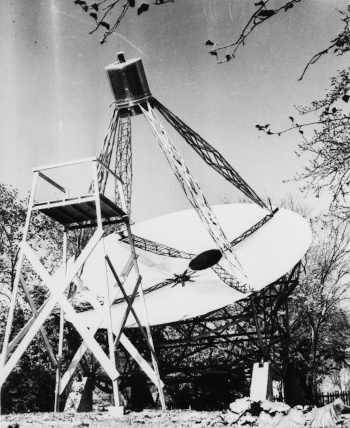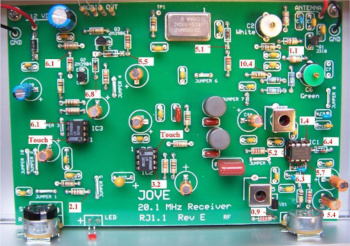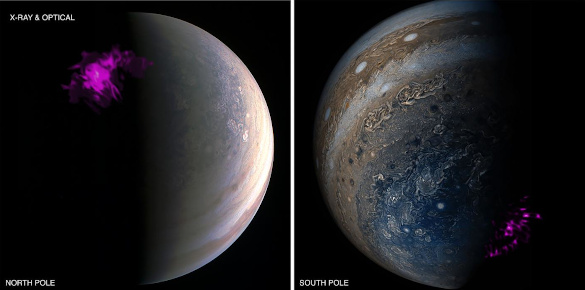Jovian Radiation
August 30, 2021
One obvious thing done by early
radio astronomers was to point their
antennas towards the
Sun. Something that big and
energetically radiating must be
pumping out detectable radio waves.
Radar operators had detected solar radio waves during
World War II, but this information was kept
secret. The first
published account was by
pioneer radio astronomer,
Grote Reber (1911-2002), who conducted
observations at 160
MHz.[1] Reber found a solar radio
intensity at this
frequency of 10
-22 watts per
cm2 per
circular degree per MHz, and he noted that this intensity was much less than that observed for the central
Milky Way source in
Sagitarius, now known as
Sagittarius A.[1] The solar radio emission is still much greater than what would be expected from
black body radiation.

The now iconic image of Grote Reber's first radio telescope antenna, built at his home in Wheaton, Illinois, a suburb of Chicago, in 1937.
Reber was an an amateur radio operator (W9GFZ). He built this 31.4 foot diameter parabolic antenna from galvanized iron, which was an inexpensive, conducting metal. Reber stated that he spent $2,000 of his own money, roughly equivalent to his annual salary, in its construction.
Wheaton, Illinois was also the home of astronomer, Edwin Hubble (1889–1953), originator of Hubble's law and for whom the Hubble Space Telescope is named.
(NRAO photograph by Grote Reber, via Wikimedia Commons. Click for larger image.)
Jupiter is often called a failed
star. It has an
atmosphere that's composed of about 75%
hydrogen and 24%
helium by
mass, which are the same
elements in stars. However, Jupiter would need about 20 times its mass to develop enough internal
pressure and
temperature to initiate hydrogen
fusion. Even a failed star emits radio waves, a discovery made in 1955 by Bernard Burke and Kenneth Franklin of the
Carnegie Institution of Science in Washington.[2] They detected Jovian radio bursts at 22.2 MHz that matched the period of the
planet's rotation.[2] Jovian radio bursts are of two types - long bursts of up to several
seconds, and short bursts lasting a few tens of
milliseconds.
While other
cosmic radio waves are so weak that they can only be detected with the huge radio telescopes used by radio astronomers, such radio signals from Jupiter are so powerful that anyone can detect them with a simple
radio receiver.
Radio JOVE, created in 1998 by James Thieman, a radio astronomer at
NASA's Goddard Space Flight Center (Greenbelt, Maryland), and presently run as a
non-profit organization by Thieman and a group of other radio astronomers, sells
kits for building such receivers.[3]

Radio JOVE receiver circuit board.
The receiver operates at 20.1 MHz, and the circuit design dates back to 2012. Other options are the presently available software-defined radios (SDRs) that interface to computers by a USB connection. These are inexpensive, but an additional upconverter is needed to allow reception at Jovian radio frequencies.
A simple dipole antenna operable at 20.1 MHz is about twenty feet long, and building it takes a little work. The Radio Jove website gives antenna construction directions, but I would advise checking information from the American Radio Relay League about antenna safety.
The software that I use for my (non-Jovian) SDR radio reception in Linux is gqrx, but other operating systems have similar applications.
(NASA/Radio JOVE Project image from the JOVE Receiver Kit Assembly Manual. Click for larger image.)
One thing that the
Earth and Jupiter have in common is
lightning.
lightning strikes occur on Earth at least a billion times each year, and lightning strikes have been detected on Jupiter.[4] There's radio emission from Jupiter lightning, just as on Earth, but only at low frequencies.[4]
Experiments by
Joseph R. Dwyer (b. 1963) and his
colleagues in 2003 showed that the
leaders of Earth lightning emit bright bursts of
x-rays thought to be caused by
Bremsstrahlung emissions from
relativistic electrons accelerated in
air by the intense
electric fields.[5-6] Jupiter is also a strong emitter of x-rays, not by lightning, but by another process.[7-10]
Recently, a huge international team of
planetary scientists have published an
open access paper in
Science Advances that describes the mechanism for x-ray emission from Jupiter.[7] The team has members from the
Chinese Academy of Sciences (Beijing, China),
University College London (Dorking, United Kingdom), the
Smithsonian Astrophysical Observatory (Cambridge, Massachusetts), the
British Antarctic Survey (Cambridge, United Kingdom),
Johns Hopkins University (Laurel, Maryland), the
Southwest Research Institute (San Antonio, Texas), the
University of Texas at San Antonio (San Antonio, Texas), the
Université de Liège (Liège, Belgium),
Northumbria University (Newcastle upon Tyne, United Kingdom),
Wuhan University (Wuhan, China), the
European Space Agency (ESA), the NASA Goddard Space Flight Center (Greenbelt, Maryland), the
University of Iowa (Iowa City, Iowa), and the
Imperial College London (London, United Kingdom).
The origin of Jupiter's x-rays has remained unknown since its discovery forty years ago.[7] This recent research shows that the x-rays are produced by Jovian
aurorae that are similar to aurorae on Earth; this, despite the fact that the energies are
orders of magnitude greater - hundreds of
gigawatts.[7-8] Jupiter's x-ray aurorae are produced by
mega-electronvolt (MeV) ions of
sulfur and
oxygen captured from
volcanic activity of its
moon, Io.[7]

Overlaid images of Jupiter's north pole (left) and south pole (right) from NASA's JJuno spacecraft and Chandra X-ray Observatory. The x-ray aurorae are shown in purple atop visible images from Juno.
(NASA Chandra/Juno Wolk/Dunn image via University College London. Click for larger image.)
The x-rays often
pulse in a
period of a few tens of minutes coincident with emissions in the
ultraviolet,
infrared, and radio spectra.[7] Jupiter's x-ray bursts are triggered by periodic
vibrations of Jupiter's
magnetic field lines that create
plasma waves that cause the sulfur and oxygen ions to travel along them, ultimately impacting Jupiter's atmosphere and generating x-rays in the process.[8,10] Says
William Dunn of University College London and
co-principal investigator of the study,
"We have seen Jupiter producing X-ray aurora for four decades, but we didn't know how this happened. We only knew they were produced when ions crashed into the planet's atmosphere... Now we know these ions are transported by plasma waves - an explanation that has not been proposed before, even though a similar process produces Earth's own aurora. It could, therefore, be a universal phenomenon, present across many different environments in space."[8]
The x-ray emission from Jupiter's
south pole consistently pulse with an 11 minute period, but the
north pole emissions are erratic with intensity that's independent of those at the south pole.[10] Earth's north and south aurorae behave similarly to each other.[10] Why Jupiter's magnetic field lines vibrate with this periodicity is unclear, but the vibration might be caused by interaction with the
solar wind or some
plasma dynamics in Jupiter's magnetosphere.[8] Jupiter's magnetic field is about 20,000 times stronger than Earth's field, so its magnetosphere is extremely large.[8]
This
research was funded by the Chinese Academy of Sciences, the
Science and Technology Facilities Council (STFC) of the United Kingdom, the
Royal Society, the European Space Agency (ESA) and NASA, among other sources.[8]
References:
- Grote Reber, "Cosmic Static", The Astrophysical Journal, vol. 100 (November 1944), pp. 279ff., doi:10.1086/144668.
- B. F. Burke and K. L. Franklin, "Observations of a variable radio source associated with the planet Jupiter," Journal of Geophysical Research, vol. 60, no. 2 (June, 1955), pp. 213-217, https://doi.org/10.1029/JZ060i002p00213.
- Stephanie Zeller, "Radio JOVE From NASA: Tuning In to Your Local Celestial Radio Show," NASA's Goddard Space Flight Center, December 4, 2018.
- Juno Solves 39-Year Old Mystery of Jupiter Lightning, NASA Press Release no. 2018-128, June 6, 2018.
- Joseph R. Dwyer, Martin A. Uman, Hamid K. Rassoul, Maher Al-Dayeh, Lee Caraway, Jason Jerauld, Vladimir A. Rakov, Douglas M. Jordan, Keith J. Rambo, Vincent Corbin, and Brian Wright, "Energetic Radiation Produced During Rocket-Triggered Lightning," Science, vol. 299, no. 5607 (January 31, 2003), pp. 694-697, DOI: 10.1126/science.1078940.
- Lightning's X-ray zap, BBC, January 31, 2003.
- Zhonghua Yao, William R. Dunn, Emma E. Woodfield, George Clark, Barry H. Mauk, Robert W. Ebert, Denis Grodent, Bertrand Bonfond, Dongxiao Pan, I. Jonathan Rae, Binbin Ni, Ruilong Guo, Graziella Branduardi-Raymont, Affelia D. Wibisono, Pedro Rodriguez, Stavros Kotsiaros, Jan-Uwe Ness, Frederic Allegrini, William S. Kurth, G. Randall Gladstone, Ralph Kraft, Ali H. Sulaiman, Harry Manners, Ravindra T. Desai and Scott J. Bolton, "Revealing the source of Jupiter's x-ray auroral flares," Science Advances, vol. 7, no. 28 (July 9 2021), article no. eabf0851, DOI: 10.1126/sciadv.abf0851. This is an open access article with a PDF file available here.
- Scientists solve 40-year mystery over Jupiter's X-ray aurora, University College London Press Release, July 9, 2021.
- W. R. Dunn, G. Branduardi-Raymont, L. C. Ray, C. M. Jackman, R. P. Kraft, R. F. Elsner, I. J. Rae, Z. Yao, M. F. Vogt, G. H. Jones, G. R. Gladstone, G. S. Orton, J. A. Sinclair, P. G. Ford, G. A. Graham, R. Caro-Carretero, and A. J. Coates, "The independent pulsations of Jupiter's northern and southern X-ray auroras," Nature Astronomy, vol. 1 (October 30, 2017), pp. 758–764, https://doi.org/10.1038/s41550-017-0262-6.
- Jupiter's X-ray auroras pulse independently, University College London Press Release, October 30, 2017.
Linked Keywords: Radio astronomy; radio astronomer; antenna (radio); Sun; rnergy; energetic; electromagnetic radiation; radiating; Solar radio emission; radar; World War II; secrecy; secret; scientific literature; published; innovation; pioneer; Grote Reber (1911-2002); radio astronomy; observation; MHz; intensity (physics); frequency; watt; centimeter (cm); square degree; circular degree; Milky Way; Sagittarius (constellation); Sagittarius A; black body radiation; Grote Reber dish antenna; cultural icon; iconic; antenna (radio); home; Wheaton, Illinois; suburb; Chicago; amateur radio operator; W9GFZ; foot (unit); diameter; parabolic antenna; galvanized; iron; cost; inexpensive; electrical conductor; metal; money; annual; salary; astronomer; Edwin Hubble (1889–1953); Hubble's law; Hubble Space Telescope; National Radio Astronomy Observatory; NRAO; Wikimedia Commons; Jupiter; star; atmosphere of Jupiter; hydrogen; helium; mass; chemical element; pressure; temperature; nuclear fusion; Carnegie Institution of Science in Washington; planet; rotation; second; millisecond; cosmos; cosmic; receiver (radio); radio receiver; Radio JOVE; NASA; Goddard Space Flight Center (Greenbelt, Maryland); foundation (non-profit); non-profit organization; electronic kit; Radio Jove receiver circuit board; circuit design; software-defined radio (SDR); serial communication interface; computer; Universal Serial Bus (USB); heterodyne; upconverter; Jovian; radio frequency; dipole antenna; Radio Jove website; American Radio Relay League; safety; Linux; gqrx; JOVE Receiver Kit Assembly Manual; Earth; lightning; lightning strike; experiment; Joseph R. Dwyer (b. 1963); colleague; leader (spark); x-rays; Bremsstrahlung; relativity; relativistic; electron; acceleration; accelerate; atmosphere of Earth; air; electric field; planetary science; planetary scientist; open access paper; Science Advances; Chinese Academy of Sciences (Beijing, China); University College London (Dorking, United Kingdom); Smithsonian Astrophysical Observatory (Cambridge, Massachusetts); British Antarctic Survey (Cambridge, United Kingdom); Johns Hopkins University (Laurel, Maryland); Southwest Research Institute (San Antonio, Texas); University of Texas at San Antonio (San Antonio, Texas); Université de Liège (Liège, Belgium); Northumbria University (Newcastle upon Tyne, United Kingdom); Wuhan University (Wuhan, China); European Space Agency (ESA); University of Iowa (Iowa City, Iowa); Imperial College London (London, United Kingdom); aurora (astronomy); aurorae; orders of magnitude; gigawatt; mega-electronvolt (MeV); ion; sulfur; oxygen; volcano; volcanic; Io (moon); north magnetic pole; south magnetic pole; Juno spacecraft; Chandra X-ray Observatory; pulse (physics); frequency; period; ultraviolet; infrared; vibration; magnetic field; plasma wave; William Dunn; co-principal investigator; decade; solar wind; magnetohydrodynamics; Jupiter's magnetosphere; research; Science and Technology Facilities Council (STFC) of the United Kingdom; Royal Society.